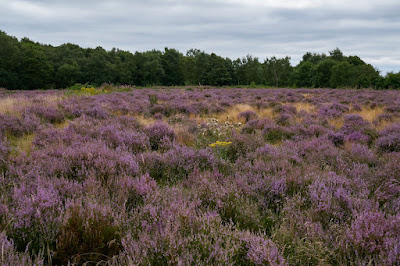Wednesday, 18th August 2021 - Steel Heath and Prees Heath
Whilst I was away in Lincolnshire my Joy of Wildlife colleagues enjoyed a day’s entertainment at two “heaths” in the north of the county.
When I returned I thought I would hear from someone about how the day had gone (assuming it had not been cancelled due to the weather).
I heard nothing.
No matter, not everyone has got the time to indulge in the “post-visit” paraphernalia that has become my habit over the years. I would find out on the following Wednesday when I re-joined the group for the outing to Snailbeach.
Wednesday came. I gave a lift to two of the attendees from the “heaths” outing.
“What happened last week?”, I enquired casually.
“Did you not get my emails?”, was the reply.
“Er, no!”, was my response.
“I spent most of Saturday preparing the species list, writing a brief report and processing the photographs.”, said one of my passengers with a slightly hurt edge to his voice.
“Er, sorry! Erm, could you please resend them?”, was the only thing I could think of to utter.
Fortunately he had not deleted them and I received copies that very evening.
But that was not the end of it.
The following day I received what appeared to be duplicates.
Closer scrutiny showed that they were the originals and had been sent on the Saturday!!!
They had taken 5 days to arrive via the electronic network. It would have been quicker to send them by post. Even 2nd Class mail would have arrived in less than 5 days.
Sometimes the postal service is referred to as “Snail Mail”. I think this is a little unfair.
According to a source on the internet the fastest speed recorded for a snail (at the time the article was written) was by Archie, a garden snail, in the World Snail Racing Championships in 1995 who covered the 13” course in 2 minutes at average speed of 0.0028 metres per second.
The shortest walking distance between the email sender’s house and mine is about 6km. Thus, if Archie had been the carrier of the emails and he made the journey at top speed without stopping, it would have taken him about 24 days to deliver it (*).
Where is this all leading you may ask.
Here is the report of the visit based on that much delayed correspondence.
We managed to park everyone's cars at Steel Heath. This was
quite an achievement as the car park is just the verge by the main road that
passes through the site and is not very large.
Steel Heath is now mainly woodland spanning the B5476 that
connects Wem to Whitchurch. The group explored the remaining clearing in the
western half of the reserve. One member of the group recalled that this area used
to be a pool and he had spent time there in the 1980’s in a search for
White-faced darters and he sent some photographs as evidence.
 |
| Photograph: Bob Kemp |
 |
| Photograph: Bob Kemp |
Sadly the pool no longer exists and is now solid ground.
A juvenile goldcrest proved to be remarkably tame and was the subject of a lot of photography.
 |
| Photograph: David Williams |
Here are photographs of some of the other animals that were found.
A harvestman, Dicranopalpus ramosus:
 |
| Photograph: David Williams |
Field grasshopper:
 |
| Photograph: Nigel Cane-Honeysett |
A spider, Pisaura mirabilis:
 |
| Photograph: Nigel Cane-Honeysett |
A hoverfly, Sericomyia silentis:
 |
| Photograph: David Williams |
Tree damselbug:
 |
| Photograph: Nigel Cane-Honeysett |
A Bronze shieldbug nymph was knocked out of an oak with its rostrum firmly attached to a 7-spot ladybird.
 |
| Photograph: David Williams |
Following the shieldbug's example lunch was taken before moving on to Prees Heath.
The area to the south of the car park was explored.
 |
| Photograph: David Williams |
It is, apparently, about 10 years since this area was planted with heather to encourage the spread of the Silver-studded blue from the main part of the reserve. Clearly the work and subsequent patience as it developed has paid off as a silver-studded blue was seen.
Lots of Field digger wasps were observed. Here is a
photograph of one.
 |
| Photograph: David Williams |
Some of the other beasts observed and photographed were:
Gorse shieldbug:
 |
| Photograph: Nigel Cane-Honeysett |
Mottled grasshopper:
 |
| Photograph: David Williams |
It was now time to go home after an enjoyable day with decent finds.
My thanks to Shropshire County Council and Butterfly Conservation for permitting us to visit their sites to do what we enjoy doing and, as always, to the photographers. Particular thanks to David for ensuring the outing ran smoothly.
Keep well.
(*) For anyone who wants to check my arithmetic, working in metres: 6000 / (0.0028 * 60 * 60 * 24) = 24.8 to 1 decimal place.












































































































